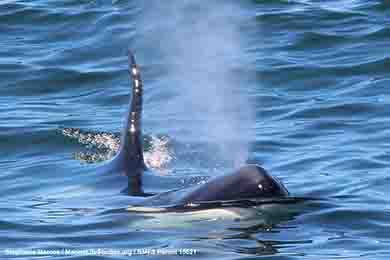Whale Entanglement Team (WET) Observes Male Orca Become Entangled in the Monterey Bay National Marine Sanctuary
April 5, 2016, during Marine Life Studies’ Research Scientist Program, we witnessed a male orca become entangled in crab pot gear and then its subsequent self-release. The whole encounter lasted only five minutes. The male orca was an animal known to researchers as CA163.
There were several orcas in the area feeding on a gray whale calf they killed in the morning. The orcas were moving in and out of a relatively small area where there were several different sets of crab pot gear. We saw the male orca heading toward one set of crab pot buoys and dove before it reached the area of the buoys. The orca came up right next to the buoys, one orange buoy and one white buoy. We were all saying, “No, no please don’t get entangled.” But that was not the case. In less then a minute we realized that he was actually entangled in the line that attached the two buoys to the crab pot on the sea floor. When he started to swim then dove; the buoys went underwater with him. The male orca surfaced a second time with the buoys trailing then dove; again pulling the buoys under. The next time he came to the surface the line was across the top of his body just in front of his tall dorsal fin with only the white buoy visible on the surface right next to him attached to the line that ran across. He dove again and when he came back to the surface he was clear of both the line and the buoys. The male orca continued to swim joining some of the other orcas in the area. Needless to say we were so relieved, but were ready to respond to assess the entanglement as well since we are the rapid response boat for the Whale Entanglement Team (WET)®. This is the first step but can only be done with authorization from NOAA.
Photos taken under NMFS Permit 15621. Left photo by Stephanie Marcos
right photo taken by Doug Croft.
right photo taken by Doug Croft.
Orcas are very curious and playful. It could be that he was just playing with the line, but it demonstrates how this behavior can lead to an entanglement. The orca was lucky he was able to clear himself from the line and buoys. An orca last year up in Fort Bragg was not so lucky. A male orca washed up on the beach in the spring of 2015 with an entanglement around one of his pectoral fins and wrapped around its tailstock.
Left photo shows line across body of orca (by Doug Croft). Photo at the right shows buoys behind orca, most likely the line is wrap around the tail stock or the fluke (by Stephanie Marcos). Photos taken under NMFS
Permit 15621 and MMHSRP Permit 18786.
Permit 15621 and MMHSRP Permit 18786.
This humpback played in kelp for 2 hours. Luckily the whale was able to break the kelp. In the bottom photo the whale had the kelp wrapped several times around its head and mouth area. If the whale had line wrapped around instead of kelp it could of led to an entanglement that would potentially prevent it from feeding. (Photo: Peggy Stap)
How you can help if you see an entangled whale:
Report immediately, call 877-SOS-WHALE (877-767-9425) or hail the U.S. Coast Guard on VHF CH-16.
If possible, please stay with the animal while maintaining 100 yards distance from the animal. Authorized personnel will guide you as what to do next.
If possible, please stay with the animal while maintaining 100 yards distance from the animal. Authorized personnel will guide you as what to do next.
Provide the following information to help authorized responders:
All photos are copyrighted. Photos taken under the MMHSRP Permit. The Whale Entanglement Team (WET)® is part of the West Coast Large Whale Entanglement Response Network.
Learn more about WET® and how you can help.
- Note the nature of the entanglement, location of the entanglement on the whale's body (i.e. a blue line wrapped around the tail (fluke) and wrapped around body by dorsal fin, description of the gear trailing (i.e. buoys if any and the number and color of the buoys, line or other gear trailing with approximate distance behind the whale the gear is trailing).
- Relay the whale's exact location (be as specific as possible, include latitude and longitude if available). Did you know you can get your exact location with your smart phone. Click to learn how.
- Other details such as is the animal swimming (speed and direction the animal is heading, is it diving or staying on the surface, is it breathing). One of the important keys to the success of freeing a whale from a life-threatening entanglement is to have someone standing by until one of our Whale Entanglement Team members arrives.
- If you are able, while maintaining 100 yards from the whale, please take high-resolution photographs of the whale including: the right and left side of the animal including the dorsal fin, the head and back on both sides, the area between the dorsal fin and the fluke (tail), the underside of the fluke if the animal is diving (if it dives it will raise its fluke vertically above the water and the underside of that fluke is a unique pattern that we can identify individual animals, like a human fingerprint), and any trailing gear or buoys.
All photos are copyrighted. Photos taken under the MMHSRP Permit. The Whale Entanglement Team (WET)® is part of the West Coast Large Whale Entanglement Response Network.
Learn more about WET® and how you can help.









